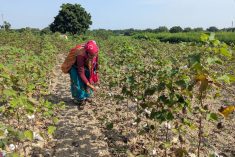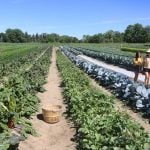Brooks is the driest place in southern Alberta as of July 30. The city and region have received only 25 percent of the normal amount of precipitation based on the 30-year long-term average of 300 millimetres.
But that’s not all.
The AgroClimatic Information Service reports the region has also recorded 23 percent more heat units than the long-term average.
“That’s sort of a one-two punch that we’ve had this year,” said Farming Smarter general manager Ken Coles.
“I think we started off with great soil moisture reserves, but everyone knows we’re well below normal on precipitation, but we’re probably about 25 percent above normal on heat, which is just going to double the impact of the extra moisture,” Coles told those gathered for a Lethbridge crop walk earlier today.
Read Also

Trade tensions boosted confidence in Canadian food system, report shows
U.S. tariff threats have boosted Canadians’ view of the nation’s food system according to the 2025 public trust report from the Canadian Centre for Food Integrity. Trust in Canadian farmers remains high but has been eclipsed by trust in scientists.
The Pincher Creek region has received 67 percent of its normal precipitation but tops the charts for exceeding its usual heat units at 145 percent of normal.
At almost 50 percent more heat than usual, “that’s probably the reason why their crops are so nice out that way,” said Coles.
Lethbridge has had 48 percent of its normal precipitation and 124 percent of its usual heat units.
Bow Island has had only 38 percent of its usual rainfall and Medicine Hat even less.
The heat factor, coupled with available irrigation across much of the south, has been a boon for corn crops in particular, though heat has helped dry land corn as well.
Taber corn was ready at the end of July, two to three weeks ahead of usual, and some farmers in the region expected to start harvesting barley and cutting canola within the next week or 10 days amid forecasts for more hot, dry weather.
Potato and sugar beet crops in the south are reported to be in promising condition. Weather conditions have kept most crop diseases at bay.
Farmers on the crop walk said spotty showers across the south have saved some dry land crops, but others are in dire condition.
barb.glen@producer.com















